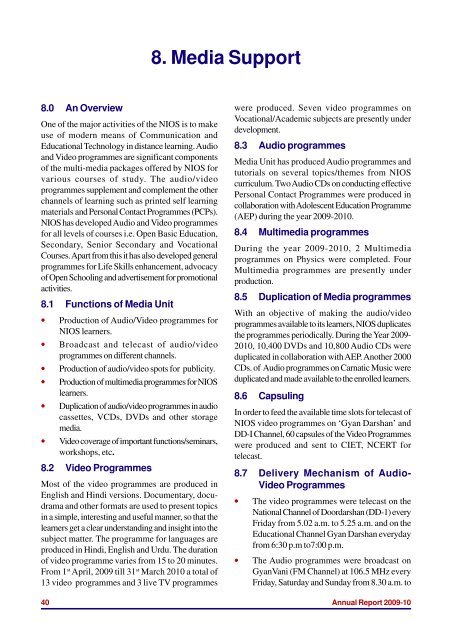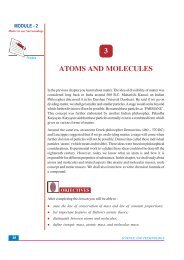2009-10 (16.6 MB) - The National Institute of Open Schooling
2009-10 (16.6 MB) - The National Institute of Open Schooling
2009-10 (16.6 MB) - The National Institute of Open Schooling
You also want an ePaper? Increase the reach of your titles
YUMPU automatically turns print PDFs into web optimized ePapers that Google loves.
<strong>National</strong> <strong>Institute</strong> <strong>of</strong> <strong>Open</strong> <strong>Schooling</strong><br />
8. Media Support<br />
8.0 An Overview<br />
One <strong>of</strong> the major activities <strong>of</strong> the NIOS is to make<br />
use <strong>of</strong> modern means <strong>of</strong> Communication and<br />
Educational Technology in distance learning. Audio<br />
and Video programmes are significant components<br />
<strong>of</strong> the multi-media packages <strong>of</strong>fered by NIOS for<br />
various courses <strong>of</strong> study. <strong>The</strong> audio/video<br />
programmes supplement and complement the other<br />
channels <strong>of</strong> learning such as printed self learning<br />
materials and Personal Contact Programmes (PCPs).<br />
NIOS has developed Audio and Video programmes<br />
for all levels <strong>of</strong> courses i.e. <strong>Open</strong> Basic Education,<br />
Secondary, Senior Secondary and Vocational<br />
Courses. Apart from this it has also developed general<br />
programmes for Life Skills enhancement, advocacy<br />
<strong>of</strong> <strong>Open</strong> <strong>Schooling</strong> and advertisement for promotional<br />
activities.<br />
8.1 Functions <strong>of</strong> Media Unit<br />
• Production <strong>of</strong> Audio/Video programmes for<br />
NIOS learners.<br />
• Broadcast and telecast <strong>of</strong> audio/video<br />
programmes on different channels.<br />
• Production <strong>of</strong> audio/video spots for publicity.<br />
• Production <strong>of</strong> multimedia programmes for NIOS<br />
learners.<br />
• Duplication <strong>of</strong> audio/video programmes in audio<br />
cassettes, VCDs, DVDs and other storage<br />
media.<br />
• Video coverage <strong>of</strong> important functions/seminars,<br />
workshops, etc.<br />
8.2 Video Programmes<br />
Most <strong>of</strong> the video programmes are produced in<br />
English and Hindi versions. Documentary, docudrama<br />
and other formats are used to present topics<br />
in a simple, interesting and useful manner, so that the<br />
learners get a clear understanding and insight into the<br />
subject matter. <strong>The</strong> programme for languages are<br />
produced in Hindi, English and Urdu. <strong>The</strong> duration<br />
<strong>of</strong> video programme varies from 15 to 20 minutes.<br />
From 1 st April, <strong>2009</strong> till 31 st March 20<strong>10</strong> a total <strong>of</strong><br />
13 video programmes and 3 live TV programmes<br />
were produced. Seven video programmes on<br />
Vocational/Academic subjects are presently under<br />
development.<br />
8.3 Audio programmes<br />
Media Unit has produced Audio programmes and<br />
tutorials on several topics/themes from NIOS<br />
curriculum. Two Audio CDs on conducting effective<br />
Personal Contact Programmes were produced in<br />
collaboration with Adolescent Education Programme<br />
(AEP) during the year <strong>2009</strong>-20<strong>10</strong>.<br />
8.4 Multimedia programmes<br />
During the year <strong>2009</strong>-20<strong>10</strong>, 2 Multimedia<br />
programmes on Physics were completed. Four<br />
Multimedia programmes are presently under<br />
production.<br />
8.5 Duplication <strong>of</strong> Media programmes<br />
With an objective <strong>of</strong> making the audio/video<br />
programmes available to its learners, NIOS duplicates<br />
the programmes periodically. During the Year <strong>2009</strong>-<br />
20<strong>10</strong>, <strong>10</strong>,400 DVDs and <strong>10</strong>,800 Audio CDs were<br />
duplicated in collaboration with AEP. Another 2000<br />
CDs. <strong>of</strong> Audio programmes on Carnatic Music were<br />
duplicated and made available to the enrolled learners.<br />
8.6 Capsuling<br />
In order to feed the available time slots for telecast <strong>of</strong><br />
NIOS video programmes on ‘Gyan Darshan’ and<br />
DD-I Channel, 60 capsules <strong>of</strong> the Video Programmes<br />
were produced and sent to CIET, NCERT for<br />
telecast.<br />
8.7 Delivery Mechanism <strong>of</strong> Audio-<br />
Video Programmes<br />
• <strong>The</strong> video programmes were telecast on the<br />
<strong>National</strong> Channel <strong>of</strong> Doordarshan (DD-1) every<br />
Friday from 5.02 a.m. to 5.25 a.m. and on the<br />
Educational Channel Gyan Darshan everyday<br />
from 6:30 p.m to7:00 p.m.<br />
• <strong>The</strong> Audio programmes were broadcast on<br />
GyanVani (FM Channel) at <strong>10</strong>6.5 MHz every<br />
Friday, Saturday and Sunday from 8.30 a.m. to<br />
40 Annual Report <strong>2009</strong>-<strong>10</strong>
















